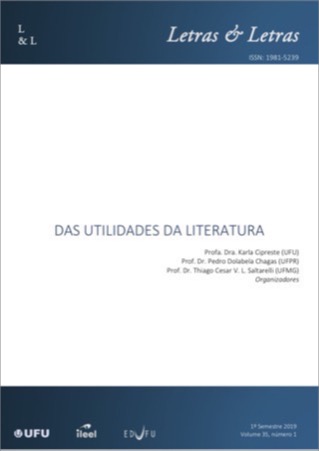On the functions and linguistic materiality of fiction
Homeostasis, Affordances, Relevance
DOI:
https://doi.org/10.14393/LL63-v35n1a2019-2Keywords:
functions of fiction, affordances, relevance, homeostasisAbstract
ABSTRACT: Proposition of homeostasis, as defined by António Damásio, as the dominant function of fiction. Proposition of the pleasure in reading as an explanation for interest in literature; explanation of this pleasure as a result of the homeostasis afforded by reading. Following Damásio, we define homeostasis as a type of psychic balance provided by the experience of art, which allows, in the course of its enjoyment, that individuals and collectivities process social issues which have yet to be properly interpreted and named. Since this equilibrium is not consciously processed only, it is necessary to explain how its semantic components can become effective subconsciously; to this end, we turn to the concepts of affordances and relevance. Inspired by Terence Cave’s appropriation of James J. Gibson’s original proposition, we propose that textual affordances orient the reader in assuming a certain attitude towards the text. Dan Sperber and Deirdre Wilson’s relevance theory inspires us to propose the ways through which textual contents produce the homeostatic equilibrium proposed as function of fiction. In the end, we discuss the extent of our theorization and the possible limits to its universalization.
Downloads
References
BARTHES, Roland. O prazer do texto. 6. ed. São Paulo: Perspectiva, 2015.
BLOOM, Paul. How pleasure works: the new science of why we like what we like. New York: W. W. Norton & Company, 2010.
CURRIE, Gregory. The nature of fiction. Cambridge: Cambridge University Press, 1990.
DAMÁSIO, António. E o cérebro criou o homem. São Paulo: Companhia das Letras, 2011.
DAMÁSIO, António. The strange order of things. New York: Pantheon, 2018.
DIXON, Peter; BORTOLUSSI, Marisa. Psychonarratology: foundations for the empirical study of literary response. Cambridge: Cambridge university Press, 2003.
GERRIG, Richard. Experiencing narrative worlds. Boulder: Westview Press, 1998.
GIBSON, James. The ecological approach to visual perception. New York: Psychology Press, 1979.
ISER, Wolfgang. O ato da leitura. São Paulo: Editora 34, 1996.
KAHNEMAN, Daniel. Rápido e devagar: duas formas de pensar. São Paulo: Objetiva, 2012.
LAUB, Michel. O tribunal da quinta-feira. São Paulo: Companhia das Letras, 2016.
MORETTI, Franco. A alma e a harpia – reflexões sobre as metas e os métodos da historiografia literária. In: MORETTI, Franco. Signos e estilos da modernidade. Rio de Janeiro: Civilização Brasileira, 2007, p. 11-56.
NORMAN, Don. The design of everyday things. Philadelphia: Basic Books, 2013.
SPERBER, Dan; WILSON, Deirdre. Relevance: communication and cognition. 2. Ed. Oxford: Blackwell, 1996.
SPERBER, Dan; WILSON, Deirdre. Meaning and relevance. Cambridge: Cambridge University Press, 2012.
SPOLSKY, Ellen. The contracts of fiction: cognition, culture, community. Oxford: Oxford University Press, 2015.
Published
How to Cite
Issue
Section
License
The authors retain author's rights but grant the journal the right of firsth publication. The works are licensed under Creative Commons Attribution License, which allows sharing provided that the authors and this journal are properly ackonwledged.













